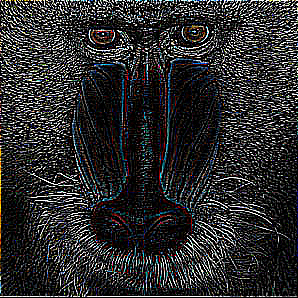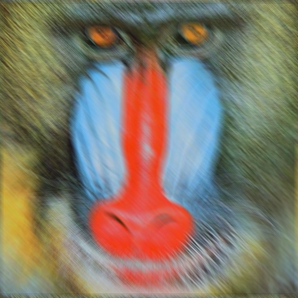 Using Data Types
Using Data Types
The purpose of this assignment is to give you practice using objects and data types.
The first exercise focuses on the
String
data type;
the second exercise involves the
Color
and
Picture
data types.
| repeats | diagnosis |
| 0–9 | not human |
| 10–35 | normal |
| 36–39 | high risk |
| 40–180 | Huntington’s |
| 181– | not human |
Write a program Huntingtons.java to analyze a DNA string
for Huntington’s disease and produce a diagnosis.
To do so, implement the following public API:
public class Huntingtons {
// Returns the maximum number of consecutive repeats of CAG in the DNA string.
public static int maxRepeats(String dna)
// Returns a copy of s, with all whitespace (spaces, tabs, and newlines) removed.
public static String removeWhitespace(String s)
// Returns one of these diagnoses corresponding to the maximum number of repeats:
// "not human", "normal", "high risk", or "Huntington's".
public static String diagnose(int maxRepeats)
// Sample client (see below).
public static void main(String[] args)
}
Here is some more information about the required behavior:
substring(), equals(), and length()
methods from the String library.
replace() method from the String library.
Use \n to specify a newline character
and \t to specify a tab character.
maxRepeats() and removeWhitespace() methods
must take time linear in the length of the string.
main() method should
In class.
Here are a few sample executions:
~/Desktop/oop1> cat repeats4.txt TTTTTTTTTT TTTTTTTTTT TTTTTTTTCAGCAGCAGCAG TTTCAGCAGT TTTTTTTTTT TTTTTTTTTT TTTTTTTTTT TTTTTTTTTTTTTCAGTTTT TTTTTTTTTT T ~/Desktop/oop1> java-introcs Huntingtons repeats4.txt max repeats = 4 not human ~/Desktop/oop1> cat repeats64.txt TTTTTTTTTT TTTTTTTTTT TTTTTTTTTT TTTTTTTTTT TTTTTTTTTT TTCAGCAGCA GCAGCAGCAG CAGCAGCAGC AGCAGCAGCA GCAGCAGCAG CAGCAGCAGC AGCAGCAGCA GCAGCAGCAG CAGCAGCAGC AGCAGCAGCA GCAGCAGCAG CAGCAGCAGC AGCAGCAGCA GCAGCAGCAG CAGCAGCAGC AGCAGCAGCA GCAGCAGCAG CAGCAGCAGC AGCAGCAGCA GCAGTTTTTT TTTTTTTTTT TTTTTTTTTT TTTTTTTTTT TTTTTTTTTT TTTTTTTTTT ~/Desktop/oop1> java-introcs Huntingtons repeats64.txt max repeats = 64 Huntington's ~/Desktop/oop1> java-introcs Huntingtons chromosome4-hd.txt max repeats = 79 Huntington's ~/Desktop/oop1> java-introcs Huntingtons chromosome4-healthy.txt max repeats = 19 no Huntington's
KernelFilter.java that applies various
kernel filters
to images, such as Gaussian blur, sharpen, Laplacian,
emboss, and motion blur.
A kernel filter
modifies the pixels in an image by replacing each pixel with a linear
combination of its neighboring pixels.
The matrix that characterizes the linear combination is known as the kernel.
More specifically, to apply a kernel filter to a grayscale image, perform the following operation for each pixel p:
To apply a kernel filter to a color image, perform the above operation to the red, green, and blue components of each pixel p separately, and combine the results.
The following table describes the kernel filters that you will implement and illustrates the results using a classic test image (baboon.png):
| image filter | kernel | result |
| identity | \( \left [ \begin{matrix} 0 & 0 & 0 \\ 0 & 1 & 0 \\ 0 & 0 & 0 \end{matrix} \right ] \) |  |
| Gaussian blur | \( \displaystyle \frac{1}{16} \;\; \left [ \begin{matrix} 1 & 2 & 1 \\ 2 & 4 & 2 \\ 1 & 2 & 1 \end{matrix} \right ] \) |  |
| sharpen | \( \left [ \begin{matrix} 0 & -1 & 0 \\ -1 & 5 & -1 \\ 0 & -1 & 0 \end{matrix} \right ] \) |  |
| Laplacian | \( \left [ \begin{matrix} -1 & -1 & -1 \\ -1 & 8 & -1 \\ -1 & -1 & -1 \end{matrix} \right ] \) |  |
| emboss | \( \left [ \begin{matrix} -2 & -1 & 0 \\ -1 & 1 & 1 \\ 0 & 1 & 2 \end{matrix} \right ] \) |  |
| motion blur | \( \displaystyle \frac{1}{9} \;\; \left [ \begin{matrix} 1 & 0 & 0 & 0 & 0 & 0 & 0 & 0 & 0 \\ 0 & 1 & 0 & 0 & 0 & 0 & 0 & 0 & 0 \\ 0 & 0 & 1 & 0 & 0 & 0 & 0 & 0 & 0 \\ 0 & 0 & 0 & 1 & 0 & 0 & 0 & 0 & 0 \\ 0 & 0 & 0 & 0 & 1 & 0 & 0 & 0 & 0 \\ 0 & 0 & 0 & 0 & 0 & 1 & 0 & 0 & 0 \\ 0 & 0 & 0 & 0 & 0 & 0 & 1 & 0 & 0 \\ 0 & 0 & 0 & 0 & 0 & 0 & 0 & 1 & 0 \\ 0 & 0 & 0 & 0 & 0 & 0 & 0 & 0 & 1 \end{matrix} \right ] \) |  |
To do so, implement the following public API:
public class KernelFilter {
// Returns a new picture that applies the identity filter to the given picture.
public static Picture identity(Picture picture)
// Returns a new picture that applies a Gaussian blur filter to the given picture.
public static Picture gaussian(Picture picture)
// Returns a new picture that applies a sharpen filter to the given picture.
public static Picture sharpen(Picture picture)
// Returns a new picture that applies an Laplacian filter to the given picture.
public static Picture laplacian(Picture picture)
// Returns a new picture that applies an emboss filter to the given picture.
public static Picture emboss(Picture picture)
// Returns a new picture that applies a motion blur filter to the given picture.
public static Picture motionBlur(Picture picture)
// Test client (ungraded).
public static void main(String[] args)
}
Here is some more information about the required behavior:
main() method should test each of your public methods.
Kernel filters are widely used for image processing in applications such as Photoshop or GIMP. They are also used in convolutional neural networks to extract features from an image and in digital cameras to remove camera shake.
Submission.
Submit a .zip file containing
Huntingtons.java and
KernelFilter.java.
Use only Java features that have already been introduced in the course
(e.g., String, In, Color, and Picture,
but not regular expressions).